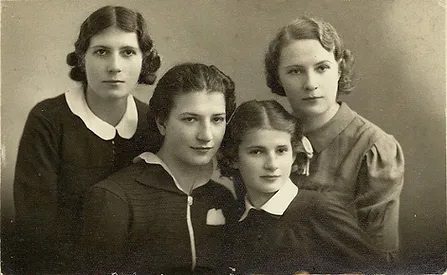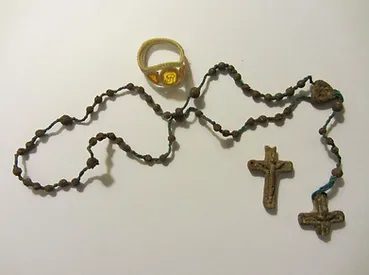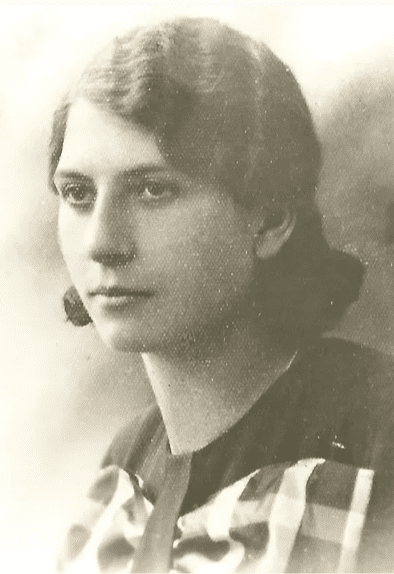Irena Piwarska: “She was the best of us all”
The first contribution comes from Magda Thomas, Friend of The SWW2LN and one of the ‘stars’ of the BBC TWO series Secret Agent Selection: WW2
If you watched the series, Magda was the expert stalker! And if you didn’t … it’s now on Netflix as Churchill’s Secret Agents: The New Recruits.
Magda tells the tragic story of her great-aunt who served in the Polish Resistance.
”She was the best of us all” my grandmother used to say about her sister Irena. I heard the story of my great-aunt, who was killed during the war, so many times that I know it by heart.
Irena Piwarska, the eldest of four Piwarski sisters, including my grandmother Stanisława, lived with her family in Suwałki. At that time the Suwałki region looked like a headland, bordered on one side with Lithuania and on the other with East Prussia. It was potentially an easy target for invaders.
In September 1939 Soviet soldiers did arrive and then, after Germany agreed with Russia that Russian soldiers would withdraw towards Augustów, the German occupation started.
A resistance movement began to form here very early on and by October 1939 Captain Stanisław Bielicki ”Ziomek” gathered a group of people and started to organise underground activities. My great-aunt Irena, who knew Bielicki before the war, also helped them and some members of this group hid in her family home.
At that point nobody was aware that that there was a traitor among them – Zygmunt Majchrzak, a German spy who was a spy even before the war started. He constantly updated the Gestapo with information on the Suwałki underground movement, and they waited patiently for the group to grow. The impulse to start arrests was a plan to blow up a cinema in Suwałki during an upcoming film premiere.
This cinema was attended only by German soldiers and officials so was a perfect target for such an operation. Unfortunately, a few days before the planned action, all from the organisation who were known to Majchrzak were arrested. Despite months of brutal interrogations nobody gave away any details of the remaining members of the organisation, an act which also saved Irena. All captured members of the group were executed in a forest near Suwałki on 26 April 1940. German soldiers tried to mask the place where the bodies were buried, but locals discovered it. The site in this forest is now commemorated, and there is still a huge spruce tree in my family’s garden in Warsaw which was taken from this site by my grandmother after the war.
My grandmother did not officially belong to any underground organisation – her older sister forbade her saying ”one is enough”. However, because she knew German well, she was employed at the Registry Office for Poles. While working there, she was able to arrange false IDs and registration certificates. The documents were then handed over to the resistance movement by Irena.
In 1940 Irena began to work in the group of Jakub Śliwiński ”Sęp”. Another organisation operating in that area was the group of Stanisław Wydornik ”Burza”.
Here, however, there was also a traitor – Edward Warakomski. His cooperation with the Gestapo started differently than in the case of Majchrzak, in that he volunteered for the Gestapo after joining the underground organisation. The decision to appoint Warakomski as head of intelligence of the organisation had tragic consequences. He became the head of intelligence in the whole Suwałki resistance, so he was able to get to know the entire underground movement of the Suwałki Region. As a result of his reports to the Gestapo, 200 people were arrested in a few days in May 1941. My grandmother was also arrested and she was convinced that the reason for her arrest was her involvement in forwarding the identification documents to the resistance.
During interrogation by the Gestapo, two guns were shown to her and she then realised that it was probably not about her activities, but those of her sister Irena. She was still hoping that her sister would manage to hide somewhere. Unfortunately, Irena was also soon arrested and taken to the prison. Someone informed the Gestapo that they had arrested the wrong sister and my grandmother was released after a few days. She said that probably no one had ever cried as much as she when leaving prison, as she knew what fate would likely await Irena for dealing with weapons. Irena, as one of the most active members of the Śliwiński group, was brutally interrogated, but she did not betray anyone.
Her family was not allowed to see Irena for the next year while she was imprisoned in Suwałki. Then, in June 1942, the prisoners were taken to a prison in Königsberg in East Prussia [now Kaliningrad in Russia]. My grandmother visited her sister there three times, risking her life, because to get there she had to travel by train ‘nur für Deutsche’ – ‘only for Germans’. The first visit was in the autumn of 1942 to the Altbau prison, and then before the trial to the modern Neubau prison. Terrifyingly modern. My grandmother did not know it then, but the prison was run like a factory, indeed a death factory and a science laboratory in one.
The prison reported to the Prosecutor General of East Prussia and was built shortly before the war, with hundreds of identical doors to cells marked with capital letters: U for prisoners under investigation, S for prisoners following convictions and Z for prisoners sentenced to death. All prisoners were dressed in black caftans and black denim trousers. Prisoners sentenced to death had white 10-centimeter wide stripes sewn on their chests, sleeves and trouser legs.
My grandmother waited for a week for the verdict in the case of Irena and other members of the Śliwiński group. After the sentence, she was permitted to see Irena but she could not learn from her what the sentence was. Irena told her that it wasn’t so terrible and that she wasn’t the only one. Only when grandmother asked the guard in German did she learn the worst – the death penalty by beheading on a guillotine.
Before the war, death sentences were carried out at Neubau by beheading with an axe. Because of the much larger number of sentences during the war it was decided to install a guillotine in the prison in 1940. It was constructed based on the model from the French Revolution. Sentences were carried out once or twice a week, each time several to around a dozen prisoners were beheaded.
A few weeks after the sentence, the court sent a letter to all the families of convicted prisoners informing them that they could receive a pass for one person for a last visit in the Königsberg prison. For the third time my grandmother went to Königsberg with her mother as her carer. She also managed to see her sister in prison because, having the same first name as her mother, she was able to use the same pass. The last visit to see her sister went seemingly calmly. Irena apologised and thanked her. Her hair was very grey and it was as if she was already no longer with them.
These were the last days of April and she died on the Polish Constitution Day on the 3rd of May 1943, when she was 32 years old.
After her death, her family received a last letter from her and a package with her clothes and small souvenirs: a rosary made of bread, a chain made of horsehair, a hand-made ring with a monogram, secret letters in clothing and some of Irena’s hair that was cut off and tied. Similar parcels were received by families of the other young people who were murdered during this time.
On the same day as Irena died, the head of their organisation Jakub Śliwiński and other members: Adela Gadomska, Leokadia Orłowska, Tadeusz Krotkiewicz, Antoni Gałązewicz and Henryk Dełkus were executed.
My grandmother then tried to find out what happened to her sister’s body. Someone told her that she would be better off not knowing. She then learned from post-war publications of how the process was organised.
Before the execution, blood was taken from the healthy prisoner which was then given to lazarets [hospitals for those infected with contagious diseases]. After the execution, the bodies served students of the nearby medicine faculty and some bodies went to the soap factory which was located near the Stutthof concentration camp. This methodology and practicality shows how dehumanised the treatment of these people was, people whose sole crime was to fight to defend their country.
Recalling her last visit to prison, Irena’s mother wrote: ‘She amazed me with her calmness, contempt for death, hatred for them and love for Poland.’ A similar approach can be felt when reading Irena’s last letter to her family: ‘My hour has already come. Today, on the 3rd of May 1943 I have to part with the world. Dear Mother, just as you saw me in the last visit, so today I am cool and calm. My life no longer belongs to this world. I am asking you only one thing – be as strong as I am now. It will bring me relief. (…) Live happily.’
My grandmother’s greatest desire was to save her sister from oblivion, and others who were killed at this time. People who wanted to live so badly, but ultimately died too soon.
Magdalena Thomas
June 2020
Based on the memories of my grandmother Stanisława Siestrzeńcewicz née Piwarska and the books of Aleksander Omiljanowicz ”Listy spod gilotyny” and ”Było to nad Czarną Hańczą

The Piwarski sisters, with Irena far left and Stanisława – grandmother of Magda Thomas – second from left

The rosary and ring made by Irena while in prison.
This section of our web site is reserved for stories of family/friend connections to relevant ‘secret war’ accounts.
If you have one of your own that you feel worthy of a wider audience, please submit it for consideration via [email protected]
